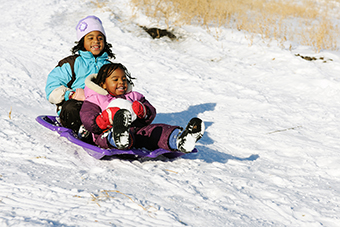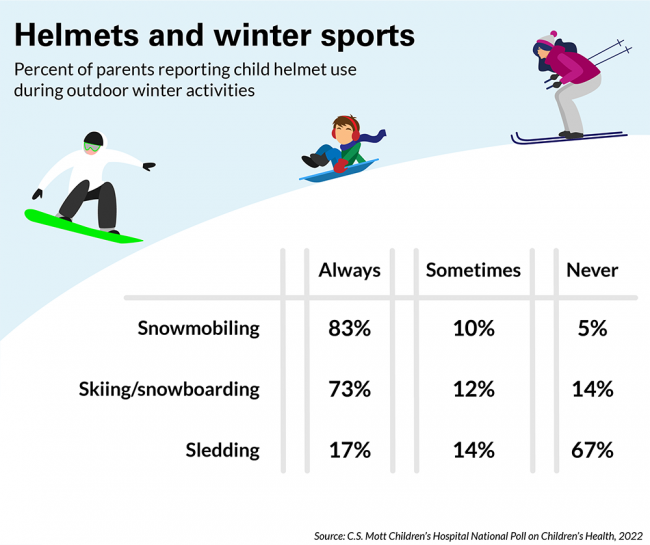Keeping kids safe during outdoor winter activities


Keeping kids safe during outdoor winter activities
Winter is a time for children to enjoy a variety of outdoor activities, some of which have a risk of injury. The C.S. Mott Children’s Hospital National Poll on Children’s Health asked a national sample of parents of children 3-18 about how they keep children safe during winter activities.
Three-quarters of parents (76%) say their child will experience winter weather, either living in a place that has frequent (40%) or occasional (30%) cold and snow or when visiting cold-weather places (6%).
Parents of children who will experience winter weather report that the most common outdoor activity both younger (3-9 years) and older (10-18 years) children will do is sledding (62% younger, 46% older). Fewer parents say their child will participate in downhill skiing or snowboarding (11% younger, 17% older) or snowmobiling (5% younger, 4% older).
Nearly all parents whose child will participate in snowmobiling (94%) or downhill skiing or snowboarding (90%) say they have talked with their child about safety rules for that activity. Fewer parents have talked about safety rules for sledding (83%). For all activities, the proportion of parents who say they discussed safety rules does not differ for younger vs older children.
Most parents report that their child wears a helmet when snowmobiling (83% at all times, 10% some of the time) and downhill skiing or snowboarding (73% at all times, 12% some of the time). Relatively few parents say their child wears a helmet when sledding (17% at all times, 14% some of the time). The proportion of parents who say their child wears a helmet does not differ for younger vs older children for any activities.
Most parents of younger children say their child has adult supervision at all times when snowmobiling (95%), downhill skiing or snowboarding (93%), and sledding (82%). For older children, parents report more supervision for snowmobiling (69% at all times, 14% some of the time, 16% none) compared to downhill skiing or snowboarding (42% at all times, 42% some of the time, 14% none), and less supervision for sledding (30% at all times, 52% some of the time, 18% none).

Highlights
- Among parents whose child goes sledding, 1 in 6 have not talked with their child about safety rules.
- Only 1 in 3 parents report their child wears a helmet when sledding.
- Over half of parents say their child aged 10-18 years does not have adult supervision when sledding, downhill skiing or snowboarding.
Implications
Activities like sledding, downhill skiing, snowboarding, and snowmobiling offer a fun and exciting way for children to enjoy the winter months outdoors. Parents need to remember that they are responsible for understanding the risks associated with these activities and taking steps to minimize the chance of injury to their child.
Because sledding is so common, parents may overlook safety concerns. Most important is the hill where the child will be sledding. Parents should not allow children to sled where the hill ends in a street, parking lot, pond or fence; instead, the bottom of the hill should have a flat runoff area with sufficient room for the sled to slow down. Children should not sled on a hill where there are trees, rocks, or other objects that might cause a collision. The steepness of the hill should be appropriate for their child’s age and experience. Parents should also check if the hill is icy, which can cause sleds to spin out of control or overturn.
In recent years, some child health organizations, such as the American Academy of Pediatrics (AAP), have advised parents to consider having their child wear a helmet when sledding. This suggestion reflects the risk of head injury if the child falls or collides with another sledder or object. Only one-third of parents in this Mott Poll reported their child wears a helmet when sledding. However, use of helmets when sledding may increase over time, similar to the increase in children wearing helmets when skiing.
Parent safety considerations may differ for downhill skiing or snowboarding, which often take place at a designated ski facility that has responsibility for staffing and maintaining the slopes. Parents should ensure their child’s helmet, boots and other equipment fit properly and are worn correctly; if parents are unsure, they may enlist the help of ski facility staff.
Before a child goes sledding, skiing or snowboarding, parents should be sure to discuss safety rules. For younger children who are sledding, parents should both describe and demonstrate the process for getting up the hill and for quickly moving to the side once they are at the end of the run. It’s important to discuss ways to avoid collisions, such as taking turns and waiting until it’s clear before starting down the hill, and what do in the event of a fall or collision. For skiing and snowboarding, having children take a lesson, especially their first time out, will help them learn proper safety precautions.
Very young children need supervision at all times, either from a parent or another trusted adult. This allows parents to ensure children are following safety rules, and to decide to leave if the area is getting too crowded or if other people are acting unsafely. As children get older, parents may decide to allow their child to go sledding, skiing or snowboarding with other children, making sure the children have a cell phone and that a parent will be available to respond quickly should there be an injury or other emergency.
Parent responsibilities when their child goes snowmobiling are quite different from other winter activities. The AAP recommends that children under age 16 do not drive snowmobiles, and driver certification or training requirements vary from state to state. Whether children are snowmobile drivers or passengers, they should always wear goggles and helmets that meet motorcycling requirements, stay on marked trails, travel at safe speeds, and have adult supervision.
Winter weather is often a concern. Parents can check the weather forecast to inform their decisions about whether and how long children can be outdoors. When the temperature is very low, children should wear layered clothes and make sure their face, ears and hands are covered, without scarves or loose strings that could get caught and pose a choking hazard. Taking occasional breaks indoors can help children avoid frostbite. Finally, children should wear sunscreen when outside during the daytime, even when it’s cold.

Data Source & Methods
This report presents findings from a nationally representative household survey conducted exclusively by Ipsos Public Affairs, LLC (Ipsos) for C.S. Mott Children’s Hospital. The survey was administered in October 2021 to a randomly selected, stratified group of adults who were parents of at least one child age 1-18 years living in their household (n=2,020). Adults were selected from Ipsos’s web-enabled KnowledgePanel® that closely resembles the U.S. population. The sample was subsequently weighted to reflect population figures from the Census Bureau. The survey completion rate was 61% among panel members contacted to participate. This report is based on responses from 1,992 parents with at least one child age 3-18. The margin of error for results presented in this report is ±1 to 7 percentage points and higher among subgroups.
Findings from the C.S. Mott Children’s Hospital National Poll on Children’s Health do not represent the opinions of the University of Michigan. The University of Michigan reserves all rights over this material.
Citation
Clark SJ, Schultz SL, Gebremariam A, Singer DC, Freed GL. Keeping kids safe during outdoor winter activities. C.S. Mott Children's Hospital National Poll on Children's Health, University of Michigan. Vol 40, Issue 2, January 2022. Available at: https://mottpoll.org/reports/keeping-kids-safe-during-outdoor-winter-activities.
